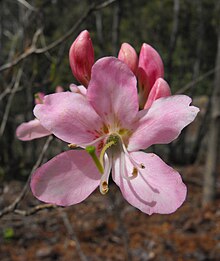Rhododendron vaseyi
| Rhododendron vaseyi | |
|---|---|
 |
|
| Scientific classification | |
| Kingdom: | Plantae |
| (unranked): | Angiosperms |
| (unranked): | Eudicots |
| (unranked): | Asterids |
| Order: | Ericales |
| Family: | Ericaceae |
| Genus: | Rhododendron |
| Subgenus: | Pentanthera |
| Section: | Rhodora |
| Species: | R. vaseyi |
| Binomial name | |
|
Rhododendron vaseyi A.Gray 1879 |
|
| Synonyms | |
|
|
Rhododendron vaseyi is a species of flowering plant in the heath family known by the common name pinkshell azalea. It is endemic to North Carolina in the United States, where it is known only from the southern Appalachians in and near Great Smoky Mountains National Park.
This deciduous shrub may grow up to 5 meters (almost 17 feet) in height. The large flowers are pink and begin to bloom in April. This species was first collected in 1878 by G. R. Vasey, son of botanist George Vasey and named in honor of both father and son.
In the wild, this species grows in acidic moist and wet substrates near bogs and streams. It may occur alongside other types of Rhododendron, such as Rhododendron maximum. The understory is made up of many ericaceous species such as Vaccinium spp. and Leucothoe editorum. The plant can often be found in areas of the forest that have been recently cleared by logging operations.
Threats to this plant in the wild include destruction of habitat as land is converted to residential use, and poaching.
...
Wikipedia

